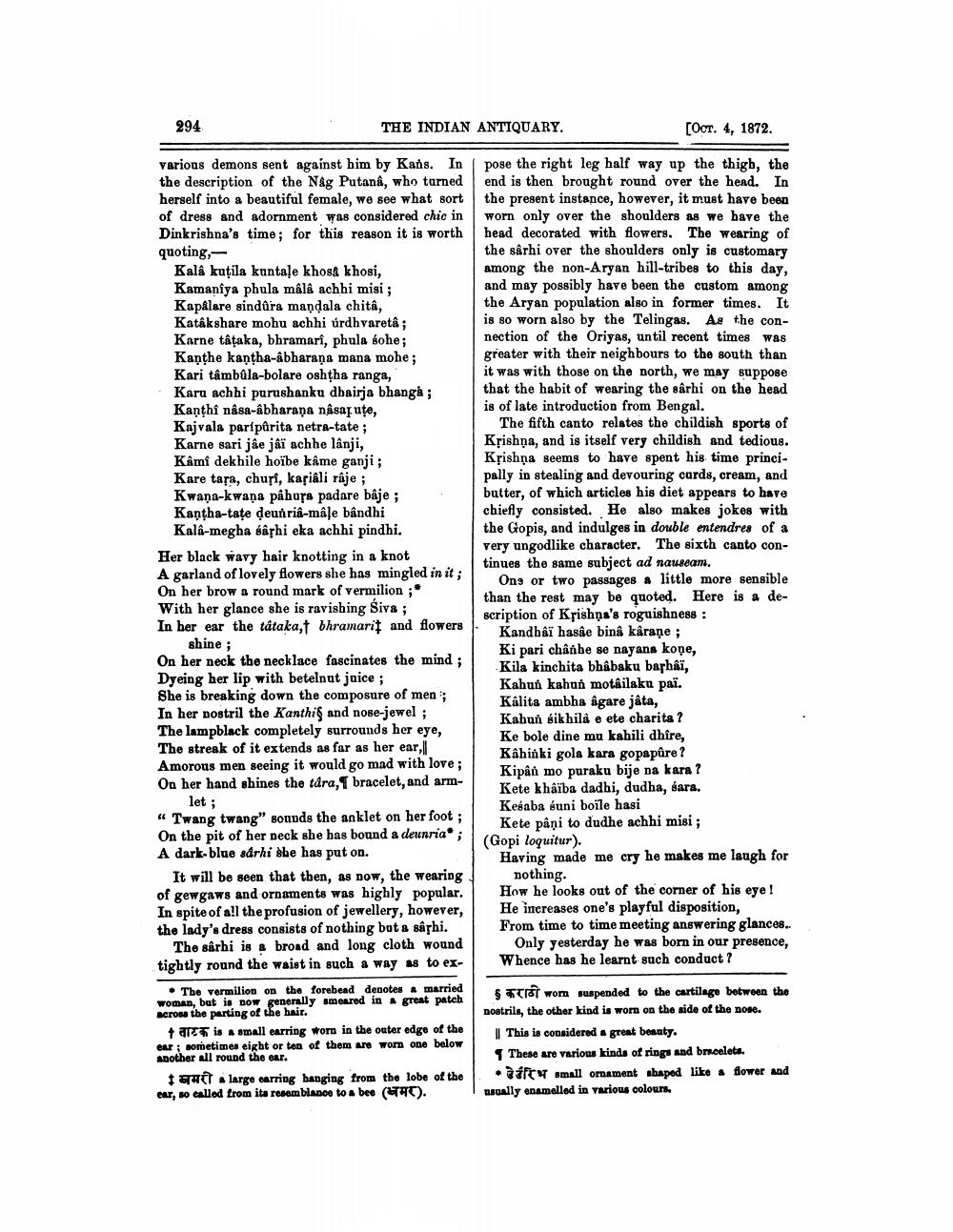________________
294
THE INDIAN ANTIQUARY.
[Oct. 4, 1872.
various demons sent against him by Kans. In the description of the Nag Putanâ, who turned herself into a beautiful female, we see what sort of dress and adornment was considered chic in Dinkrishna's time; for this reason it is worth quoting,
Kalâ kuțila kuntale khosa khosi, Kamaniya phula mâlâ achhi misi; Kapalare sindura mandala chita, Katakshare mohu achhi úrdhvaretâ ; Karne tâţaka, bhramari, phula sohe; Kanthe kantha-âbharaṇa mana mohe; Kari tâmbala-bolare oshtha ranga, Karu achhi purushanku dhairja bhanga; Kanthi nâsa-ábharaṇa nâsar ute, Kajvala pariparita netra-tate; Karne sari jâe jâï achhe lânji, Kâmi dekhile hoibe kême ganji; Kare tașa, chusi, kariâli raje ; Kwaņa-kwaņa pahusa padare båje; Kantha-tate deun riê-måle bândhi
Kalâ-megha sashi eka achhi pindhi. Her black wavy hair knotting in a knot A garland of lovely flowers she has mingled in it; On her brow a round mark of vermilion ; With her glance she is ravishing Siva ; In her ear the tátaka, bhramarit and flowers
shine ; On her neck the necklace fascinates the mind; Dyeing her lip with betelnut juice ; She is breaking down the composure of men; In her nostril the Kanthis and nose-jewel; The lampblack completely surrounds her eye, The streak of it extends as far as her ear,ll Amorous men seeing it would go mad with love; On her hand shines the tåra, 1 bracelet, and arm
let; “ Twang twang" sounds the anklet on her foot ; On the pit of her neck she has bound a deunria; A dark-blue särhi she has put on.
It will be seen that then, as now, the wearing of gewgaws and ornaments was highly popular. In spite of a!l the profusion of jewellery, however, the lady's dress consists of nothing but a sâhi.
The särhi is a broad and long cloth wound tightly round the waist in such a way as to ex
• The vermilion on the forebead denotes « married woman, but is now generally smeared in a great patch across the parting of the hair.
+ art is a small earring worn in the outer edge of the GAT { sometimes eight or ten of them are worn one below another all round the ear.
1 H large carring hanging from the lobe of the ear, so called from ita resemblance to a bee (THT).
pose the right leg half way up the thigh, the end is then brought round over the head. In the present instance, however, it must have been worn only over the shoulders as we have the head decorated with flowers. The wearing of the sârhi over the shoulders only is customary among the non-Aryan hill-tribes to this day, and may possibly have been the custom among the Aryan population also in former times. It is so worn also by the Telingas. As the connection of the Oriyas, until recent times was greater with their neighbours to the south than it was with those on the north, we may suppose that the habit of wearing the sârhi on the head is of late introduction from Bengal.
The fifth canto relates the childish sports of Krishna, and is itself very childish and tedious. Krishna seems to have spent his time principally in stealing and devouring cards, cream, and butter, of which articles his diet appears to have chiefly consisted. He also makes jokes with the Gopis, and indulges in double entendres of a very ungodlike character. The sixth canto continues the same subject ad nauseam.
Ons or two passages a little more sensible than the rest may be quoted. Here is a description of Krishna's roguishness :
Kandhár hasâe binâ kâraņe; Ki pari chânbe se nayana kone, Kila kinchita bhabaku bashâï, Kahun kahun motailaku paï. Kalita ambha ägare játa, Kabun sikhila e ete charita ? Ke bole dine mu kahili dhire, Kâhinki gola kara gopapûre ? Kipan mo puraku bije na kara ? Kete khâība dadhi, dudha, bara. Kesaba kuni boile hasi
Kete pâņi to dudhe achhi misi; (Gopi loquitur). Having made me cry he makes me laugh for
nothing. How he looks out of the corner of his eye! He increases one's playful disposition, From time to time meeting answering glances..
Only yesterday he was born in our presence, Whence has he learnt such conduct ?
S o wom suspended to the cartilage between the nostrils, the other kind is worn on the side of the nose. || This is considered a great beauty, These are various kinds of rings and broelets.
ifry small Ornament shaped like a flower and usually enamelled in various colours




